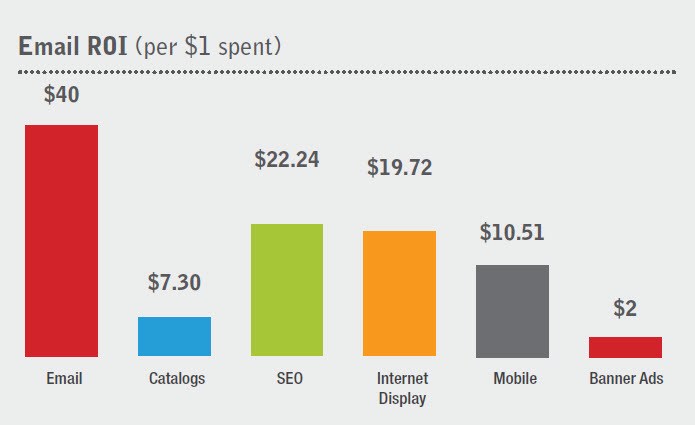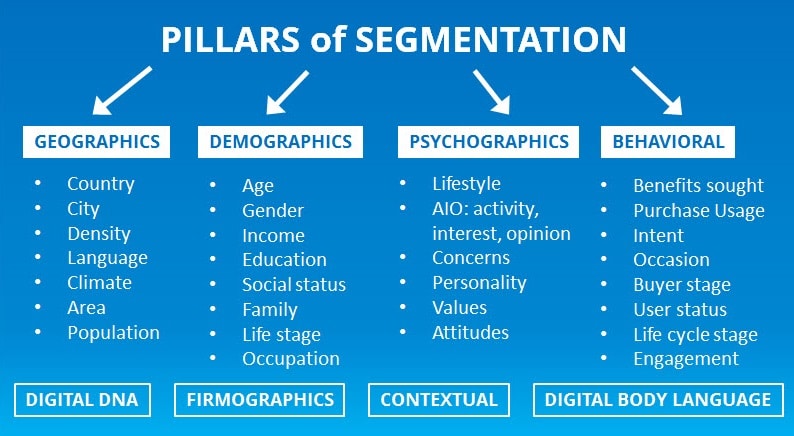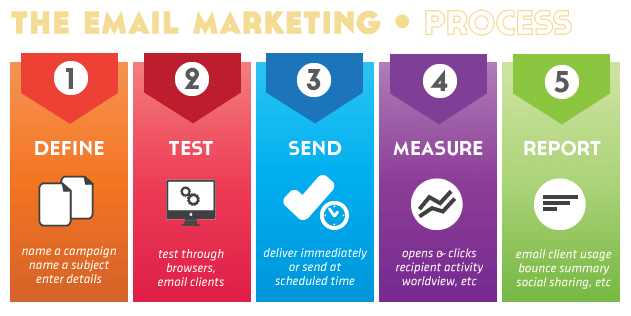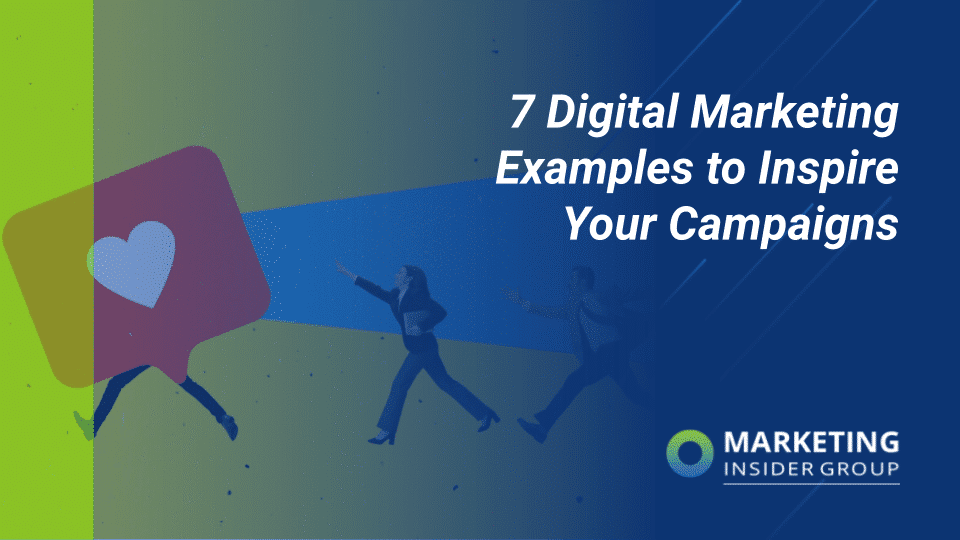
How to Run Successful Email Marketing Campaigns Step by Step
Successful email marketing is a critical, and often overlooked, element of digital marketing. The right content at the right time landing in someone’s inbox can break through the noise, capture their attention, nurture their interest, and convert.
The question, then, is this: Do you know how to run a successful email marketing campaign?
According to an article on Inc:
But after a couple decades of Nigerian prince schemes, Spanish lotto scams, and mountains of unsolicited spam (which is never a good marketing tactic), how do people feel about email now? Is it still a worthwhile tactic for small-business owners and marketers to pursue?
The simple answer is yes.
Take a look at the graphic below and you’ll see how important successful email marketing is to your bottom line–generating nearly 2X the ROI of the next more cost-effective tactic.

Quick Takeaways:
- Email doesn’t just generate awesome revenue, it also has the power to facilitate genuine connections and build long-term relationships.
- Email marketing can help businesses of all sizes achieve a variety of goals. Start by having an overarching goal for each email campaign.
- Pay attention to the subject line, body content and design of your emails.
- The metrics you choose to track and report are critical to email marketing success.
We’ve put together this step-by-step guide to running a successful email marketing campaign. But, before we jump into it, some background.
Why Run Email Marketing Campaigns?
Every day, an estimated 306.4 billion emails are sent and received worldwide, and this number is only set to increase over the years. The graph below shows the number of sent and received emails per day worldwide from 2017 to 2023, in billions.

The numbers are clear – email is going nowhere fast. If your business is to remain competitive now and into the future, it must learn how to use email to its advantage to secure more leads and sales.
It’s not just about generating revenue, either. Email marketing earns $44 for every dollar spent – higher than any other marketing tactic.
Email is a tried-and-true avenue for personalization, too, and we all know by now how critical the individualized customer journey is in today’s business landscape.
The Ultimate Step-By-Step Guide to Email Marketing Campaigns
Step 1: Set Your Goals
All marketing efforts should start with setting goals – email marketing is no different. Before you can plan and execute your campaign, consider what, specifically, you want to achieve. Here are a few examples to get you thinking:
- Boost engagement with your brand, which might include inviting subscribers to a webinar or prompting them to connect with you on social media
- Nurture leads, which will likely involve delivering high-value content
- Re-engage subscribers that haven’t been active
- Segment subscribers so you can send more targeted campaigns in the future
- Make sales
Step 2: Know Your Audience
You probably already have a vague idea of who your audience is, but vague won’t cut it when it comes to producing successful email marketing campaigns that help you achieve your goals.
“Consumers are constantly being inundated with emails, so yours has to stand out. It is important that your audiences are segmented properly. You want to avoid the “spray and pray” method.” – Forbes
Segmentation is critical. Your audience can be segmented into groups according to their demographics, behaviors, and the stage of the customer journey they’re in. You can use past campaigns and data from analytics, social media, and even third-party data collectors to improve the accuracy of your segmentation.

Step 3: Determine Email Types
So, you’ve set a goal and identified your audience. Now it’s time to bridge the gap between the two. You’ll want to select an email type that aligns with both your objectives and your audiences’ needs and wants.
Here are some of the most common email types:
- Promotional emails: These share information about sales and special offers, new products, events, and other company news.
- Relational emails: These give subscribers what you’ve promised, such as a monthly newsletter, a discount code for signing up, a conversational email, or relevant information they have requested.
- Transaction emails: These are typically triggered by an action on your website and might include:
- Signup confirmations
- Welcome messages
- Acknowledgment of changes to account or subscriber information
- Purchase and shipping confirmations
Step 4: Plan Your Emails
Emails need to be timely, interesting, relevant, and valuable, regardless of their type, goal, and audience. A connected campaign should also be consistent and unfold in some sort of narrative. In other words, it should make logical sense and stand as a whole – it’s a common tactic to reference past emails in your campaign.
In the rough stages of planning, trying noting down the following:
- Frequency
- Type of email(s)
- Overall theme
- A basic outline of content for each email
- The action you want subscribers to take
Here’s a process and template for a more detailed email marketing plan.

Step 5: Craft Your Emails
An email is comprised of three components: the subject line, body content, and visual design. Let’s take a look at each.
Subject line
The subject line is critical – if it doesn’t resonate or capture your subscriber’s attention, the entire campaign is lost on them. Your subject line should be short and intriguing but must be relevant to what’s actually inside the email.
Body content
The length of your email isn’t necessarily significant. What’s critical is the content itself. It must be valuable and in line with your brand’s voice. It’s also a good idea to address the reader by their name and include one clear call-to-action.
Design
Your email should be legible and on-brand. Before you hit send, be sure your design looks good on your mobile device.
Step 6: Send, Test, and Track Key Metrics
Your email is ready. But hitting send isn’t the last step. It’s crucial to collect data to optimize future campaigns. Test everything from the subject line to the design and layout. Monitor your analytics, too, including clicks, unsubscribes, and forwards.
The Keys to Successful Email Marketing
1. List Building
Before you can have a successful email marketing campaign, you need a good list. In the bad old days before CAN-SPAM, you could simply buy a list and spam a bunch of folks with your message. Some experts advised against such “cold messaging”, but it worked well if you were very selective in purchasing a list of likely buyers. List buying was an art in those days and I got paid a lot of money to guide businesses on which list purchases were likely to result in high returns. And, selling lists is what kept a lot of small, specialty magazines in business–they provided unique access to highly targeted subscribers.
Now, of course, you can’t buy lists, so you have to develop your own (and comply with CAN-SPAM regulations which you can find by following the link above). Since, the law makes your email client (for instance, Constant Contact, AWeber, or MailChimp) responsible for your violations, they can get hit with a big fine, so they’re invested in keeping you honest in this.
So how do you go about building a list?
- Include your sign-up form everywhere-on the home page and each page of your website, in your store (if you’re a brick and mortar), at events, on social platforms …
- Offer something (like an ebook, coupon, etc) in exchange for signing up for your email list
- Don’t ask for information you don’t need so it’s fast and easy for visitors to sign up. Maybe all you need is an email address and name. Don’t forget you can get additional information after they sign up.
- Make your sign-up form obvious without interfering with user experience (I hate those popups that block content until you either sign up or x out). I prefer a small band at the bottom of the screen that asks for an email address or something that pops up as the visitor starts to scroll away from your site. Remember, your website is critical for SEO and you don’t want to mess with anything that reduces visits, bounces, or time on site.
- When you send an email, include social sharing and the ability to subscribers to forward your email to a friend. These are great ways to build your list.
2. Strong Content
Just like everything in marketing, the message is everything.
- Make your content (both text and images) attractive and inviting, use lots of white space and a little humor doesn’t hurt. The more an email looks like a personal conversation with a friend, the better it will perform.
- Personalization doesn’t end with including the person’s name. Make the email look like it was designed especially for each reader.
- Don’t waste your readers’ time with nonsense: say what you need and provide links to more information.
3. Timing
You don’t want to overload your readers by sending too many emails, but you want to use your email marketing to build loyalty and engagement with your target audience. That’s a tight balancing act.
And, there’s no one-size-fits-all answer to this question. A good gauge of the right frequency comes from analytics. If your open rates drop or you start getting complaints or a bunch of folks unsubscribe, you’re probably emailing too often. If you’re not getting folks unsubscribing or complaining, you could probably send more frequent emails.
The key is to send emails when you have something worth saying to your audience.
4. Marketing Automation
Marketing automation often receives a negative knee-jerk reaction because it sounds like you’re treating your subscribers as robots who all get treated the same. But, it’s actually the opposite. Whether you prefer Salesforce or HubSpot or some other marketing automation tool, successful email marketing requires you send the right content to the right people at the right time and that means using marketing automation.
No marketing automation platform works well unless you spend time keeping information up-to-date to ensure the content the subscriber receives is targeted to their product interests, stage in the customer journey, and other key elements, like gender. For organizations and companies that have got their automation right, it’s time to consider the use of AI in email marketing.
5. Analytics
The wonders of digital marketing provide a plethora of metrics which should guide every marketing decision you make. Here are some metrics you should watch:
- Subscriber data such as new subscribers and unsubscribes
- Performance of your email form–I do this by setting up goals in Google Analytics, but AWeber also shows me how many times my form was shown and how many subscribers were generated. I periodically do A/B testing to determine the optimal form, placement, etc.
- Campaign performance–how many opens, how many clicks, and, if you’ve installed tracking codes, goal completions based on each campaign.
6. Mobile-friendliness
Making your content mobile-friendly is a key to successful email marketing. According to Buffer, 47% of emails are opened on a mobile device. Here’s their advice for making your content easier for mobile users:
- Convert your email to a one column template for an easy mobile fix.
- Bump up the font size for improved readability on smart phones.
- Follow the iOS guideline of buttons at least 44 pixels wide by 44 pixels tall.
- Make the call-to-action obvious and easy to tap. Above the fold is preferable.
- Consider ergonomics. Many users tap and scroll with their thumb, so keep important tappable elements in the middle of the screen.
7. Customer Focus
Rob Krekstein explains how to use email to drive real business results: Do not simply send out emails. Create one that equates to leads, sales pipeline and new customer sales revenue.
Even in the current environment where it seems that we each receive 50 emails a day from companies selling their services, email can still work.
Here are a few tips for how to make this successful as well as some metrics as proof points:
- The email should be simple and concise. Too often we want to try and have the email sell the product for us, by including a lot of value propositions and verbiage. This is done to attempt to increase the value of the prospect that “opens” the email, but in fact this will only serve to lower your response rate. Open with a compelling statement (or Hard Offer), followed up by 2-3 bullet points, then that action button at the bottom.
- The messaging must be compelling. Do not utilize a generic message or some industry information, but be direct and bold with your statement. Let the prospect know within seconds why they should read on and eventually click the action button on the bottom. This usually requires some prior analytics or understanding of your target audience.
- The CTA must be specific. The entire purpose of the email is to get as many prospects to click that Action Button as you can. Be sure and use verbiage that explains exactly WHAT they will receive once they click, Do not be ambiguous and make sure you are using a compelling tactic (Demo / Free Trial / Free Study), “White Papers” are NOT very compelling.
- The landing page should be informative. This is where you can add further explanation of your services and add assets that might be interesting to the prospect. People are prepared to spend more time on a Landing Page so this is your chance to give them the “WOW Factor”.
- You need to follow up within 24 hours. Most “experts” will say that the value degrades most significantly after 48 hours of response, but I feel that immediate contact is necessary to achieve optimal results. You need to create a process that allows for a response to all prospects that opened or clicked through the email within hours, as well as technology that showcases their activity on your landing page so you can direct the follow up call to their specific interest.
After extensive testing, utilizing these simple tactics have generated 62-73% more responses, a 42% increase in leads and a 29% increase in sales.
Create Your Successful Email Marketing Campaign Now!
Here’s a nice infographic with quick dos and don’ts for successful email marketing:
Email marketing is a process – the more you do it, the more data you collect, the higher your ROI. Use this step-by-step guide as a starting point and see what works for your brand and audience.







Thanks for the great tips. Obviously everyone needs great content, but it’s not enough anymore to just have free content. You have to tailor every aspect of your email marketing campaigns to your audience.
Absolutely! In a world with so much digital information, you have to add precision to the mix.